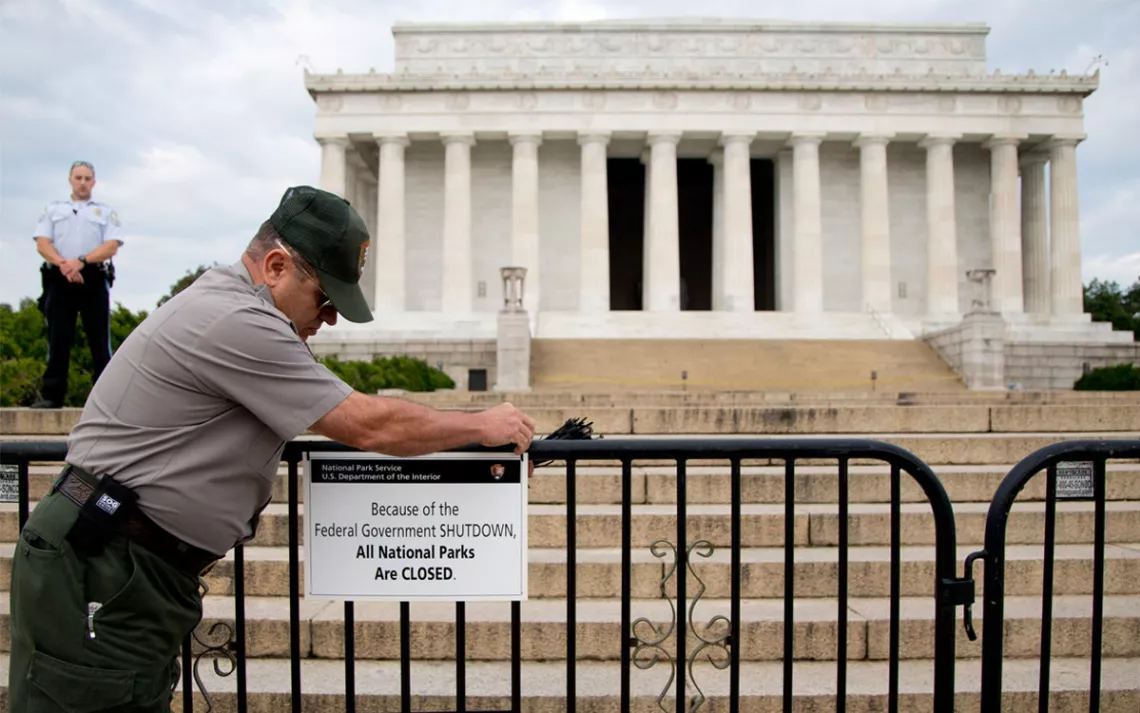What Does the Government Shutdown Mean for the Environment and Public Health?
Most national parks will close, EPA will shutter, food inspections will cease

Photo by AP/Carolyn Kaster
Unless Republicans in the House of Representatives defy all expectations and get their side of the chamber in order, the federal government will shut down at midnight on Saturday.
The shutdown will have immediate and drastic effects on millions of Americans. While some federal programs will quickly grind to a halt, others that are deemed “necessary to protect life and property” will continue at various levels of functioning. Still others may rely on contingency or state funding to keep them going, at least for a while.
Meanwhile, hundreds of thousands of government workers will go on immediate furlough, and all of the approximately 2 million federal employees will forgo paychecks until the shutdown ends. The shutdown will create negative ripple effects throughout the economy.
Here’s how the shutdown will affect public health, the environment, and recreation.
Public lands and recreation
On Friday, the Department of the Interior announced that national park sites will be shuttered if the shutdown proceeds. It’s not just that families have to forgo their trips to Yosemite. The many satellite businesses that depend on parks for revenue—lodgings, restaurants, and outfitters—will also suffer. The National Parks Conservation Foundation estimates that parks and gateway communities could lose as much as $70 million for every day the government is shut down.
With Yellowstone National Park in his backyard, Senator John Barrasso, a Republican from Wyoming, well understands the economic importance of parks to his constituents, and on September 20 he urged Department of Interior Secretary Deb Haaland to use her authority to keep national parks and other public lands open in the event of a shutdown—a clear case of trying to cherry pick which services stay open and which get closed.
During the 2018 shutdown, the National Park Service lost $400,000 in entrance fee revenues. But to avoid the sort of embarrassment Senator Barrasso fears, Trump administration officials kept some parks partially open, a move the National Parks Conservation Foundation called “reckless” and which resulted in “avoidable damage, including overflowing trash and human waste, vandalism, looting, and illegal use of off-road vehicles.”
The closure will affect not just national parks but also the popular Smithsonian museums and the National Zoo in Washington, DC. Some states, including Arizona and Utah, will use state funding to keep open popular parks like Grand Canyon and Zion.
Finally, there’s the bad bear news: The shutdown has led the Park Service to cancel Fat Bear Week; Americans will also miss out on farewell festivities for three giant pandas at the National Zoo before they return to China.
Public health and safety
The shutdown will delay routine inspections that usually hum along unnoticed but which are crucial for protecting health and safety. The Occupational Safety and Health Administration will pull back on workplace safety inspections, and the Environmental Protection Agency, where approximately 93 percent of employees will be furloughed, will limit inspections on hazardous waste sites and drinking water and chemical facilities. The agency will also be forced to halt oversight and review of permits and plans to ensure safe water and clean air and efforts to address the PFAS contamination crisis.
The Department of Agriculture will continue inspections at meat, poultry, and dairy facilities, but the FDA will be forced to limit its domestic food inspections to food-borne disease outbreaks. About 48 million Americans are sickened by contaminated food every year, and that’s with inspections.
“If these inspections stop for three days, it’s not an immediate public health emergency,” said Bobby Kogan, senior director of federal budget policy at the Center for American Progress. The risk heightens if the shutdown drags on.
“A lot of these critical functions of government prevent bad things from happening,” says Kogan. “You don’t hear about all the E. coli outbreaks that were stopped.”
Climate action
The shutdown will delay federal permitting activities, which could delay important restoration and conservation plans and projects. Developing rules and policies on greenhouse gas emissions could also be delayed. It’s unclear how the shutdown will affect the climate provisions of the Inflation Reduction Act, since the law has separate funding already approved by Congress.
More broadly, the shutdown highlights a perilous divide among lawmakers about what government programs and activities are important. In a letter to the Senate and House Appropriations Committees, Sierra Club executive director Ben Jealous warned against cuts to programs and agencies that address public health, environmental justice, and the biodiversity and climate crises. “Instead, Congress should fight for climate action, good jobs, environmental protections, and equitable outdoor access by building on the historic progress it has made on clean energy, transportation, and manufacturing,” Jealous wrote.
FEMA and federal disaster relief
A day before the shutdown, New York governor Kathy Hochul declared a state of emergency for New York City and the surrounding counties as record rainfall turned streets into lakes and subways into waterfalls—the most recent in a string of climate-related disasters. The Federal Emergency Management Agency is running out of money; in advance of the shutdown, the agency announced a pause in disaster recovery aid to several hard-hit regions totaling $2.8 billion, as reported by Grist. The delayed aid is yet another unfortunate example of the shutdown’s uneven toll, as such disasters tend to disproportionately affect low-income and minority communities.
Nutrition and food security
One of the cruelest consequences of the shutdown will be borne by some of the country’s most vulnerable residents: those who receive federal food assistance through SNAP and the 6.7 million pregnant and post-partum women, babies, and toddlers that depend on WIC.
Thanks to a contingency fund, SNAP recipients will receive their October benefits without interruption. The outlook is murkier if the shutdown drags on past mid-October. This is because the administration of the program is left to individual states, each with its own internal deadlines for processing payments. If the states don’t get the green light from the USDA to proceed with issuing payments in time, some could be delayed. Some states have more reserves then others, so the shutdown, especially if it drags on, will affect WIC recipients unevenly depending on where they live.
WIC, which delivers not just healthy food but also breast pumps, nutrition classes, and referrals to other services, is a discretionary program administered by the states. Notably, the Senate’s bipartisan Continuing Resolution would have given WIC authority to frontload some funding so that beneficiaries aren’t cut off and new applicants aren’t turned away. Some 100,000 children will be denied access to Head Start programs.
The shutdown couldn’t come at a worse time, as the need for both SNAP and WIC has only escalated, especially with the termination of pandemic assistance, says Ellen Teller, chief government affairs officer at the Food Research and Action Center.
“You only have X amount of dollars, and the dollars you had last year cannot fund as many people this year because food inflation is eating away at that,” explains Teller. “Factor in rising caseloads and you’ve got an incredible need for more funding than you had last year.”
On the other end of the fork, farmers could be denied assistance and loans at a critical time post-harvest, and wrangling over Appropriations will further delay reauthorization of the 2018 Farm Bill, which expired on September 30.
The bottom line
Given the gulf between the Senate and House and the stubborn defiance of the Far Right, it’s difficult to imagine a quick end to the shutdown, and all too easy to foresee it matching or even exceeding the 34-day shutdown that started in December 2018, which was the longest in history. Meanwhile, real people are feeling real harm, starting with federal employees. Although they will receive back pay once the government revs back up, that doesn’t negate the stress of the moment. “It’s one thing to miss a paycheck; it’s another thing to not know how many missed paychecks are coming,” Kogan says.
The longer the shutdown drags on, the more people will feel the effects, and the costlier and more destabilizing the recovery will be.
“A short shutdown looks very different than a mid-length or a long shutdown,” says Kogan, pointing out that had the Trump shutdown continued just one more week, Supplemental Security Income checks would have been interrupted. “Eventually the whole thing breaks.”
 The Magazine of The Sierra Club
The Magazine of The Sierra Club



